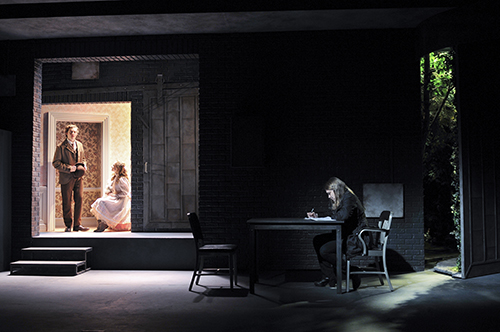There are two worlds in Jennifer Haley's
The Nether. One is reality---a dark, cold place. The other is The Hideaway, a Victorian manor filled with light and color and trees.
The latter universe is part of The Nether, an immersive virtual space that people obsessively visit in this perhaps not-so-distant future.
However, Laura Jellinek's set for MCC Theater's production, now at the Lortel, is primarily an interrogation room. It's only when the windows and doors open that we get glimpses of The Hideaway, which means we have to imagine the rest.
For actor Ben Rosenfield, imagining The Hideaway is especially important. His character, Woodnut, is an avatar---an online alter ego for someone who exists in the real world---so to ground his performance, he needs a clear mental picture of where Woodnut lives.
In order to prepare for his role, Rosenfield watched a documentary called
Life 2.0, about the online virtual world Second Life. "Virtual realities are getting more and more dynamic as time goes on, and it can really consume your life," he says. "Ultimately what the play deals with is individuals who are addicted to it. So that was something that required a certain amount of research. But addiction is broad and you can be addicted to a lot of things. There's a throughline of what those emotions are."
However clear they are to him, though, Rosenfield has to be careful about how he communicates his character's emotions.
The Nether is structured as a mystery, so there are complexities and motivations that can't be revealed too early. Woodnut, for instance, is actually a detective in the real world, and he can use his virtual ambiguity to his advantage. "A good detective wouldn't make it obvious why he's there, so it's a balancing act of trying to tell this story of a detective and at the same time not giving myself away to the other actors who I'm supposed to be hiding my true identity and motives from," Rosenfield says.
Woodnut is at The Hideaway investigating the activities that occur there. It's a place where people can have sex with and murder virtual children, living out their desires without harming others or committing crimes (all the children are the avatars of consenting adults). Most of Rosenfield's scenes are with 13-year-old Sophia Anne Caruso, who plays one of the children, Iris. There are no salacious moments, but it's still sensitive material.
In working with Caruso, however, Rosenfield didn't treat her differently because of her age. "Sophia is a really professional, smart person," he says. "She really wanted this role. We went into everything on the same page and in the same situation. And [director] Anne [Kauffman] worked with Sophia the same way she worked with me or Frank [Wood] or anyone else in the cast, which is I think the way to do it."
Rosenfield describes the rehearsal process as especially communal. Even though he doesn't have scenes with some of the other actors, the nature of the play is such that each scene informs the others, so it was valuable for him to be present as everything was created. "It was a really fun and a really unique experience because usually you're more separated," he says. "It's all important information to be gained from seeing what they were doing in the real world and vice versa."
That sense of unity has extended into performances at the Lortel. Because the play is only 80 minutes long, everyone needs to be in sync. "You need to hit these notes exactly right as you go through, or else you can really destabilize things," Rosenfield says.
After the show, Rosenfield goes home, but the play stays with him, and that's what he prefers. "I think it makes the work better," he says. "It's definitely been a hard one to leave at the theatre, and I don't want to leave it there completely because I feel like I don't want to get detached from it. I can stay close enough that I can do the show every night and be truthful."
---
Linda Buchwald tweets about theatre as @PataphysicalSci
Photo by Jenny Anderson